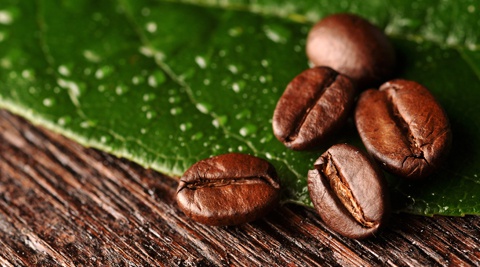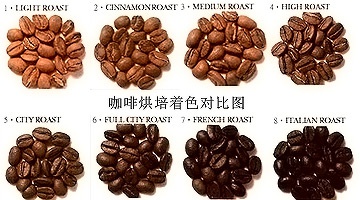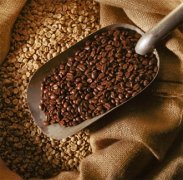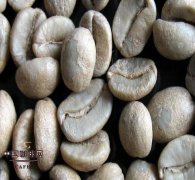The most direct factor determining whether coffee beans are sour or bitter is the roasting of coffee beans.

The raw coffee beans are roasted to make the coffee show a unique coffee color, aroma and taste. The most important thing about baking is to be able to stir-fry the inside and outside of the beans evenly without overscorching. It is no exaggeration to say that 80% of the taste of coffee depends on roasting, which is the most important and basic condition for making coffee. Roasting is a deep knowledge. Many coffee roasters study the roasting of coffee all their lives, but they are still not sure that the taste of each pot of coffee can be exactly the same.
Professionally speaking, roasted coffee can be divided into eight stages from shallow to deep. The taste of coffee is not only related to the origin and variety, but also directly related to the degree of baking. To put it simply, the shallower the degree of roasting, the sour the taste of coffee, the deeper the degree of roasting, the more bitter the taste of coffee. Let's talk about the details of each roasting degree of coffee.

1. Very shallow baking (LIGHT Roast): the degree of baking; very shallow baking, also known as shallow baking. The lightest roasting degree of all roasting stages, the surface of the coffee beans is a light cinnamon color, its taste and aroma are insufficient, this state is almost undrinkable. It is generally used for testing and seldom for tasting.
2. Shallow baking (CINNAMON Roast): baking degree; shallow baking, also known as cinnamon baking. The general baking degree, showing cinnamon color on the appearance, the smell of green has been removed, the aroma is OK, and the acidity is strong, which is a common roasting degree of American coffee.
3. MEDIUM Roast: degree of baking; moderate baking, also known as micro-baking. Medium baking heat and light baking are both American, in addition to sour taste, bitterness also appears, the taste is good. It has moderate aroma, acidity and mellowness, and is often used in the baking of mixed coffee.
4. Medium baking (HIGH Roast): baking degree; moderate micro-deep baking, also known as concentration baking. Belongs to the moderate micro-deep baking, the baking degree is slightly stronger than the slight medium baking, the surface has appeared a little thick brown, the bitterness also becomes stronger. Coffee tastes sour and bitter, with good aroma and flavor, and is most often loved by people in Japan and Central Europe. (blue Mountain Coffee)
5. Medium-deep baking (CITY Roast): baking degree; medium-deep baking, also known as urban baking. The most standard degree of roasting, bitterness and acidity are balanced and are often used in French coffee. (Brazil, Colombia)
6. Deep baking (FULL-CITY Roast): baking degree; micro-depth baking, also known as deep city baking. The baking degree is slightly stronger than the medium depth, the color becomes quite dark, and the bitter taste is stronger than the sour taste. It belongs to the Central and South American baking method, which is very suitable for preparing all kinds of iced coffee.
7. Deep baking (French Roast): degree of baking; deep baking, also known as French baking. Also known as French or European baking, belongs to deep baking, the color is thick brown with black, sour taste can not be felt, especially in Europe, France is the most popular, because the fat has infiltrated to the surface, with a unique flavor, very suitable for coffee Oulei, Viennese coffee.
8. Deep baking (Italian Roast): the degree of baking; very deep baking, also known as Italian baking. Also known as Italian baking, baking degree before carbonization, there is a scorched taste, mainly popular in Latin countries, suitable for fast coffee and cappuccino. Most of them are used in Espresso coffee series.
Important Notice :
前街咖啡 FrontStreet Coffee has moved to new addredd:
FrontStreet Coffee Address: 315,Donghua East Road,GuangZhou
Tel:020 38364473
- Prev

The roasting Tips of Espresso Coffee beans: a knowledge of mixed beans
Talking about mixed beans when we talk about baking espresso beans, we are actually talking about the science of mixed beans. The highest sweet spots of all kinds of coffee beans from different countries appear at different baking points, so bakers must find a balance between baking and mixing beans in order to make a good espresso. First of all, this subject should be based on the degree of baking and the selection of beans.
- Next

Nicaraguan competition wins coffee beans Nicaraguan coffee beans
Nicaragua Nicaragua 2005 CoE (Cup of Excellence) competition winning coffee beans, that is, the competition winning coffee beans, the output is very small, relatively rare. The appearance is very neat, basically do not need to pick, it is recommended to bake around the middle of the bean, cinnamon roast cinnamon baking degree. Nicaragua, Nicaragua, because of many lakes and volcanoes, there are volcanic lakes.
Related
- Guji coffee producing area of Guji, Ethiopia: Humbela, Shakiso, Wulaga
- What is the most expensive variety of Qiloso in BOP multi-variety group?
- How to store the coffee beans bought home?
- Why are Yemeni coffee beans so rare now?
- Ethiopian Sidamo all Red Fruit Sun Sun Santa Vini Coffee beans
- SOE is mostly sour? What does it mean? Is it a single bean? what's the difference between it and Italian blending?
- Is Italian coffee beans suitable for making hand-brewed coffee?
- How to choose coffee beans when making cold coffee? What kind of coffee beans are suitable for making cold coffee?
- Just entered the pit to make coffee, what kind of coffee beans should be chosen?
- Can only Japan buy real Blue Mountain Coffee? What are authentic Jamaican Blue Mountain coffee beans?

